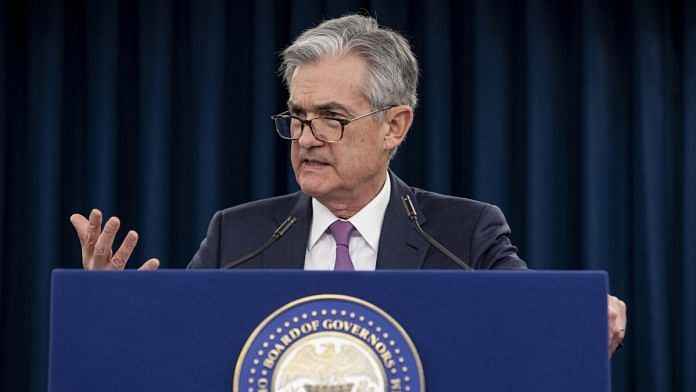Washington: The Federal Reserve kicked off a campaign of interest rate hikes that’s set to be the most aggressive since the mid-2000s, as Chair Jerome Powell assured Americans that the fight against inflation won’t tip the U.S. economy into recession.
After raising rates by a quarter point for the first time since 2018 and signaling six more increases this year, Powell told reporters that inflation is too high, the labor market is over-heated and price stability is a “pre-condition” for the central bank as it tackles the hottest price pressures in 40 years.
“As I looked around the table at today’s meeting, I saw a committee that’s acutely aware of the need to return the economy to price stability and determined to use our tools to do exactly that,” Powell told reporters Wednesday following a two-day meeting of the Federal Open Market Committee. “The American economy is very strong and well positioned to handle tighter monetary policy.”
Policy makers voted 8-1 to lift their key rate to a target range of 0.25% to 0.5% after two years of holding borrowing costs near zero to insulate the economy from the pandemic.
They forecast a sequence of rate hikes, finishing this year at 1.9% and then to about 2.8% by the end of 2023, which would be considered restrictive to growth. From June 2004 to June 2006, the Fed moved its benchmark up from 1% to 5.25%, tightening at 17 straight meetings.
Seven policy makers want an even faster pace of increases this year, which raises the prospect of a half-point move in future. Indeed, St. Louis Fed President James Bullard dissented at this meeting in favor of such an step.
“The Fed has now waged a war on inflation,” said Diane Swonk, chief economist at Grant Thornton. “They want to bring inflation down with the most aggressive surge in rates in decades.”
The Fed said that Russia’s invasion of Ukraine posed “highly uncertain” implications for the economy that create near-term upward pressure on inflation while weighing on economic activity.
Still, Powell played down the risk of recession and repeatedly stressed that the economy is “very strong” while emphasizing the need for price stability.
In their economic projections, officials laid out a path of slowing inflation and sustained expansion.
Notwithstanding the projected rate increases the forecasts showed very little increase in joblessness, which stays around 3.5% for the next three years.
Economists said that sort of happy outcome rarely happens in real life.
“The history of being able to guide inflation down from 40-year highs with maximum employment suggests a smooth landing is very difficult to achieve,” said Matthew Luzzetti, chief U.S. economist at Deutsche Bank Securities Inc. “At some point they will face the tradeoff between pushing unemployment higher or accepting higher inflation.”
Bond traders indicated some skepticism that the Fed can pull off a soft landing. A portion of the bond curve — the gap between five- and 10-year yields — inverted for the first time since March 2020. For some, that highlights a threat that the efforts to rein in inflation could trigger an economic downturn.
The economy roared into the first quarter with employers adding more than 1 million jobs in the first two months and job openings near a record high.
Strong demand sustained price increases and consumer inflation rose by 7.9% for the 12 months through February. The Fed’s 2% inflation target is based on a separate gauge, the personal consumption expenditures price index, which rose 6.1% in January.
Powell and his colleagues have pivoted rapidly from the gradualism of just three quarter-point hikes they penciled in for 2022 when they met in December to seven now, including Wednesday’s increase.
“They saw the light,” said Stephen Stanley, chief economist at Amherst Pierpont Securities LLC. “They have been underestimating the persistence and intensity of inflation pressures for at least a year. They have finally realized they have a serious problem on their hands and have to act. There is a whatever-it-takes kind of mentality” now.
The aggressive swerve is punctuated by the risk of losing a grip on price increases now, which would require higher costs to the economy later to get it back under control.
For more than two decades, Fed officials have locked down inflation to around 2%, cementing public expectations that price volatility was no longer an issue for economic decisions.
Achieving that required a punishing recession engineered by former Chairman Paul Volcker who pushed borrowing costs into the double digits.
This year, Fed officials forecast that pandemic supply-chain problems would subside, and they still do, but Wednesday’s statement noted that price pressures are spreading beyond the logistics knots at a time of wage increases.
Now they are betting a policy tilt toward a series of steady increases will keep inflation expectations anchored although the war makes the outlook more murky.
Powell was clear that if inflation doesn’t calm down, the policy committee will hammer it even harder.
Despite the rosy outlook for the labor market in the forecasts, Powell made clear that it is running too hot in his view.
“There is misalignment of demand and supply, particularly in the labor market, and that is leading to wages that are moving up that are not consistent with 2% inflation over time,” Powell said. He said job openings near record highs point to a labor market that is “tight to an unhealthy level.”
“That is a pretty extreme thing to say,” said Derek Tang, an economist at LH Meyer/Monetary Policy Analytics. “That is saying too many people have jobs and people are getting wages that are too frequent. He is really putting his thumb down on the scale now.”–Bloomberg
Also read: RBI’s outlook on inflation, growth overtaken by Ukraine war, monetary policy panel officials say



